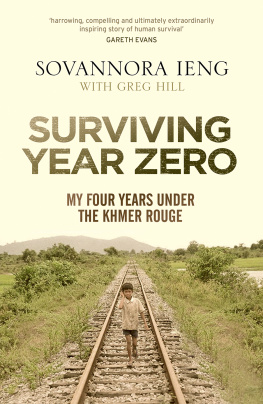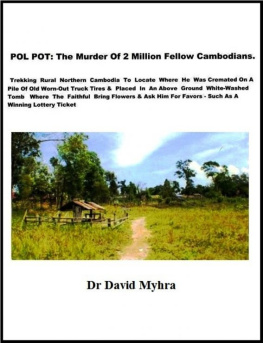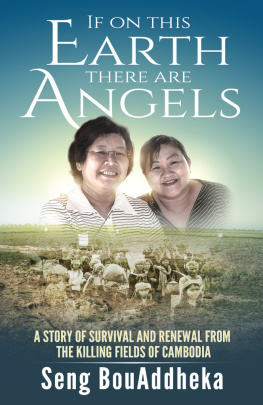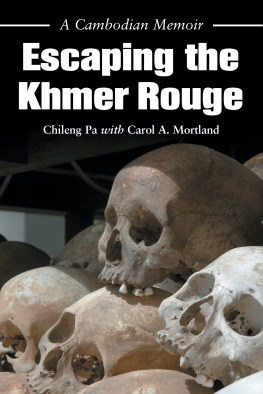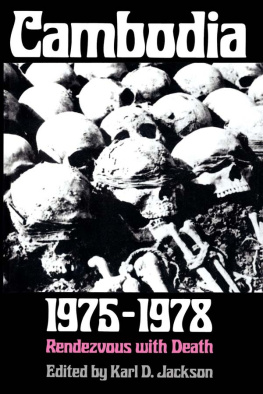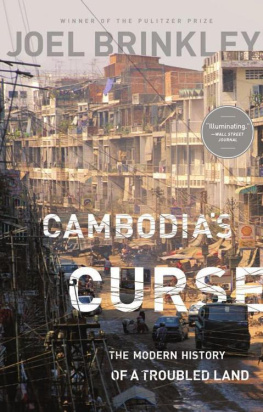
2011 Seng Kok Ung. All rights reserved.
Published by S&T Publishings 660 South King Street, Seattle, Washington 98104
If you enjoy the book please let us know by emailing us at either
or
We can also be reached on Facebook:
Seng Ung http://www.facebook.com/#!/profile.php?id=100001544338410
or Thomas McElroy http://www.facebook.com/#!/profile.php?id=1405465798
ISBN: 9781623091125
INTRODUCTION
T orture, starvation, brutal and arbitrary executions, brainwashed children spying on parents. These are only some of the horror Cambodians had to go through under the brutal Khmer Rouge regime. During their time in power selected groups of people simply disappeared. Intellectuals, people who wore glasses, doctors, and lawyers were the first to be executed. They wanted no one around who may have had the potential to undermine their plans for the new Cambodia.
The Khmer Rouge took over the country and carried out a radical program that isolated the country from outside sources, closing schools, hospitals and factories. They abolished banking, finance and currency, outlawed all religions and moved city dwellers out to the countryside where people were literally worked to death. Millions of people died through executions, work exhaustion, illness and starvation.
Family relationships not sanctioned by the state were banned. Family members could be put to death for even talking with each other. The leadership of villages even had the power over who was able to get married and to whom they would be married.
This is the backdrop of what my life was like for four long years. Amazingly, through it all, most of my family members stayed close to each other. Some of the family members died from starvation and several members were executed. To this day their bodies have never been located.
In the pages that follow is my journey through the hellish nightmare of the Khmer Rouge, to Thailand and eventually to the United States where I literally transformed myself into the quintessential American success story.
My mother and grandmother were both very serious Buddhists. Whenever they came across a farmer who was selling caged birds, they would buy the whole cage, say a Buddhist prayer and set the birds free so the birds would stay together. They prayed that their family would be like the birds and remain together. But it never came true because we have family all over the world now. This is the story of our familys flight.
Sam Ung
ACKNOWLEDGMENTS
T his book is dedicated to the memory of my mother and father and to the family members that I lost during the Khmer Rouges takeover of Cambodia.
To my brothers (Tong Meng, Kheang, Kheng, Heng, and Chai) and sister (Say Ky), who survived this horrible ordeal: I am thankful to you that we are all still close and a family. Our parents dream was to have us remain close, and we worked very hard during those years to live up to their hopes for us.
To all my nieces and nephews: This book will help you understand what your older family members endured, how it affected their lives and what eventually became of us once we reached the United States.
To my children, Dawn, Diane and Darlene, my son-in-law Damon; and my grandchildren, Devin and Derin: I wrote this book to help exorcise the horrors of my past, which I have never talked about with you. The stories in this book will allow you to understand better what our family has enduredand why we value each other so much now.
And, of course, to my wife of 30 years, Kim Ung: None of this would have been possible without you. You have been a source of strength and determination in our lives and raised our children so they could blossom. When we came to this country from a Thai refugee camp so many years ago, we started with literally nothing except each other. Thanks to our partnership, we persevered to become a true American success story.
To Kong Lu whose excellence in graphics was so valuable in the making the book. One word. Beautiful. The cover of the book is so amazing!
Finally, to Thomas McElroy: Thank you for helping me write my memoir.

MY FAMILY
M y name is Seng Kok Ung, but people call me Sam. I am 56 years old and for the last 30 years, since my wife and I escaped from Cambodia, we have lived in Seattle, Washington. I own a Cambodian restaurant called Phnom Penh Noodle House in the International District and run a catering business as well. I have been blessed with three lovely daughters and two wonderful grandchildren. I am very proud to be a citizen of the United States. The day I became a citizen was one of the best days of my life. As a child, I had never dreamt that my life would take me from my native country of Cambodia across an ocean to America. But as a child I had also never imagined that something like the Khmer Rouge occupation could ever exist. This is the story of my life during the Khmer Rouge takeover of Cambodia, my escape to America, and how I built a life here, started a family, and made this new place my home.
Let us start at the beginning.
I was born February 28, 1955, in Battambang. Its Cambodias second largest city, and is located in the northwestern part of the country near Thailand, in a province nicknamed the rice bowl of Cambodia because of its ability to produce three rice crops a year. I was the fifth of nine children born to my mother, Meng Vouch, and my father, Chan Kao.
My father was born in the city of Jieyang in Canton Province, China in 1923. He fled to Cambodia in 1937 at the age of 14 to avoid being conscripted into the Chinese Army. Many of his friends had been sent off to fight in the Sino-Japanese War (July 7, 1937-September 9, 1945) and he wanted nothing to do with it. He packed his bag with some food, said goodbye to his family members, wished them all good luck and departed.
Traveling with friends, my fathers little group walked and hitched rides to Shenzhen (about 643 kilometers), then took a boat across the South China Sea landing somewhere in Vietnam. From there the band of friends walked into Cambodia. My father never told me how long the trip took, so I can only imagine it must have taken at least several months or longer to travel that distance. They left home with nothing, and once the food ran out they turned to begging for the rest of the trip. All they had were the clothes they were wearing. Their cloth pants and shirts were dirty, torn and tattered. The soles of their shoes were worn thin with maybe a toe or two sticking out, unwashed except for stopping to bathe in local streams. They must have been quite a disheveled looking group.
My father considered himself fortunate, for he found work right away as a farm laborer. He worked from morning to night carrying dirt to various farms in the area. He didnt have a place to live yet, so he took up residence in a Buddhist temple. The monks were kind, fed him every day, and in return for the work he did, allowed him to stay at the monastery. My father lived there for four years before moving to Battambang, where he started his noodle-cart business.
My mother was born in 1927 in the city of Kampong Chhnang in Cambodia. Of Chinese-Vietnamese descent, she was the youngest of four sisters and two brothers. My grandfather owned a boat, and he traveled with it up and down the Mekong River, where he traded fruits, vegetables and wares like pots and pans with the Vietnamese, and like any good businessman, supplied anything his clients asked for. This made him a wealthy man and as a result, my mother was well educated and learned to read and write Thai, Vietnamese, Cambodian, and French, as well as three different Chinese dialects, which were TeoChew, Fukin, and Cantonese.
Next page


